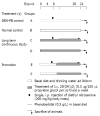1alpha, 25-dihydroxyvitamin D3 prevents DNA damage and restores antioxidant enzymes in rat hepatocarcinogenesis induced by diethylnitrosamine and promoted by phenobarbital
- PMID: 15112340
- PMCID: PMC4622764
- DOI: 10.3748/wjg.v10.i9.1268
1alpha, 25-dihydroxyvitamin D3 prevents DNA damage and restores antioxidant enzymes in rat hepatocarcinogenesis induced by diethylnitrosamine and promoted by phenobarbital
Abstract
Aim: To investigate the chemopreventive effects of 1alpha, 25-dihydroxyvitamin D(3) in diethylnitrosamine induced, phenobarbital promoted rat hepatocarcinogenesis.
Methods: The rats were randomly divided into 6 different groups (A-F). Groups A, C and E rats received a single intraperitoneal (i.p.) injection of diethylnitrosamine (DEN) at a dose of 200 mg/kg body mass in 9 g/L NaCl solution at 4 wk of age, while group B served as normal vehicle control received normal saline once. After a brief recovery of 2 wk, all the DEN treated rats were given phenobarbital (PB) at 0.5 g/L daily in the basal diet till wk 20. Group A was DEN control. Treatment of 1alpha, 25-(OH)2D3 in group C was started 4 wk prior to DEN injection and continued thereafter till wk 20 at a dose of 0.3 microg/100 microL propylene glycol per one single dose (os) twice a week. Group E received the treatment of 1alpha, 25-(OH)2D3 at the same dose mentioned as above for 15 wk. The rats in group D and F received 1alpha, 25-(OH)2D3 alone as in group C without DEN injection.
Results: The comet assay showed statistically higher mean values for length to width ratios (L: W) of DNA mass and tailed cells (P<0.01; P<0.01 respectively) in DEN treated rats as compared to their normal controls. Continuous supplementation of 1alpha, 25-dihydroxyvitaminD2 showed a significant (P<0.01) decrease in L:W ratio of DNA mass tailed cells. Furthermore, 1alpha, 25-(OH)2D3 supplementations elevated the super oxide dismutase (SOD) activity, hepatic malondialdehyde (MDA) level, reduced glutathione (GSH) and glutathione S-transferase (GST) activity (P<0.01, P<0.05, P<0.05 and P<0.05 respectively). As an endpoint marker histological changes were observed to establish the chemopreventive effects of 1alpha, 25-dihydroxyvitaminD2.
Conclusion: Supplementations of 1alpha, 25-(OH)2D3 has a marked protection against hepatic nodulogenesis, antioxidant enzymes and DNA damages in DEN induced rat hepatocarcinogenesis promoted by phenobarbital.
Figures






Similar articles
-
Combined supplementation of vanadium and 1alpha,25-dihydroxyvitamin D3 inhibit placental glutathione S-transferase positive foci in rat liver carcinogenesis.Life Sci. 2000 Dec 1;68(2):217-31. doi: 10.1016/s0024-3205(00)00930-9. Life Sci. 2000. PMID: 11191639
-
Combined supplementation of vanadium and beta-carotene suppresses placental glutathione S-transferase-positive foci and enhances antioxidant functions during the inhibition of diethylnitrosamine-induced rat liver carcinogenesis.J Gastroenterol Hepatol. 2004 Jun;19(6):683-93. doi: 10.1111/j.1440-1746.2004.03378.x. J Gastroenterol Hepatol. 2004. PMID: 15151625
-
Further evidence for chemopreventive potential of beta-carotene against experimental carcinogenesis: diethylnitrosamine-initiated and phenobarbital-promoted hepatocarcinogenesis is prevented more effectively by beta-carotene than by retinoic acid.Nutr Cancer. 2000;37(1):89-98. doi: 10.1207/S15327914NC3701_12. Nutr Cancer. 2000. PMID: 10965525
-
1 alpha,25-Dihydroxyvitamin D(3) inhibits rat liver ultrastructural changes in diethylnitrosamine-initiated and phenobarbital promoted rat hepatocarcinogenesis.J Cell Biochem. 2001 Mar 26;81(2):357-67. doi: 10.1002/1097-4644(20010501)81:2<357::aid-jcb1050>3.0.co;2-q. J Cell Biochem. 2001. PMID: 11241675
-
Experimental Hepatic Carcinogenesis: Oxidative Stress and Natural Antioxidants.Open Access Maced J Med Sci. 2017 Aug 12;5(5):686-691. doi: 10.3889/oamjms.2017.101. eCollection 2017 Aug 15. Open Access Maced J Med Sci. 2017. PMID: 28932315 Free PMC article. Review.
Cited by
-
Attenuation of constitutive DNA damage signaling by 1,25-dihydroxyvitamin D3.Aging (Albany NY). 2012 Apr;4(4):270-8. doi: 10.18632/aging.100450. Aging (Albany NY). 2012. PMID: 22498490 Free PMC article.
-
Vitamin D and cancer: a review of molecular mechanisms.Biochem J. 2012 Jan 1;441(1):61-76. doi: 10.1042/BJ20110744. Biochem J. 2012. PMID: 22168439 Free PMC article. Review.
-
Therapeutic Potential of Vitamin D and Curcumin in an In Vitro Model of Alzheimer Disease.J Cent Nerv Syst Dis. 2020 May 27;12:1179573520924311. doi: 10.1177/1179573520924311. eCollection 2020. J Cent Nerv Syst Dis. 2020. PMID: 32528227 Free PMC article.
-
6-shogaol-rich extract from ginger up-regulates the antioxidant defense systems in cells and mice.Molecules. 2012 Jul 4;17(7):8037-55. doi: 10.3390/molecules17078037. Molecules. 2012. PMID: 22763741 Free PMC article.
-
Exploring vitamin D metabolism and function in cancer.Exp Mol Med. 2018 Apr 16;50(4):1-14. doi: 10.1038/s12276-018-0038-9. Exp Mol Med. 2018. PMID: 29657326 Free PMC article. Review.
References
-
- Blutt SE, Allegretto EA, Pike JW, Weigel NL. 1,25-dihydroxyvitamin D3 and 9-cis-retinoic acid act synergistically to inhibit the growth of LNCaP prostate cells and cause accumulation of cells in G1. Endocrinology. 1997;138:1491–1497. - PubMed
-
- Beaty MM, Lee EY, Glauert HP. Influence of dietary calcium and vitamin D on colon epithelial cell proliferation and 1,2-dimethylhydrazine-induced colon carcinogenesis in rats fed high fat diets. J Nutr. 1993;123:144–152. - PubMed
-
- Welsh J. Induction of apoptosis in breast cancer cells in response to vitamin D and antiestrogens. Biochem Cell Biol. 1994;72:537–545. - PubMed
-
- Chouvet C, Vicard E, Devonec M, Saez S. 1,25-Dihydroxyvitamin D3 inhibitory effect on the growth of two human breast cancer cell lines (MCF-7, BT-20) J Steroid Biochem. 1986;24:373–376. - PubMed
-
- Sardar S, Chakraborty A, Chatterjee M. Comparative effectiveness of vitamin D3 and dietary vitamin E on peroxidation of lipids and enzymes of the hepatic antioxidant system in Sprague--Dawley rats. Int J Vitam Nutr Res. 1996;66:39–45. - PubMed
Publication types
MeSH terms
Substances
LinkOut - more resources
Full Text Sources
Other Literature Sources
Medical
Research Materials

